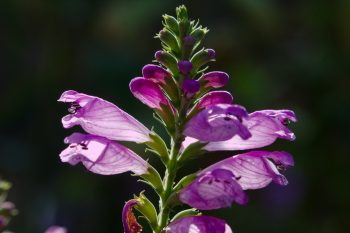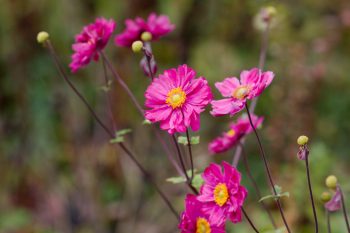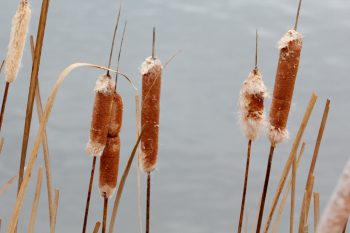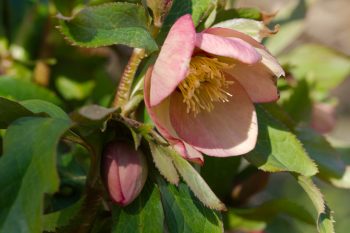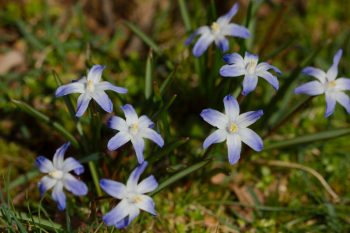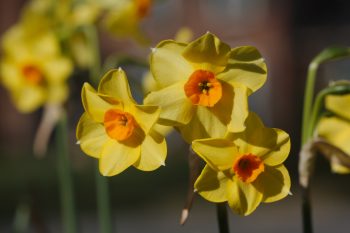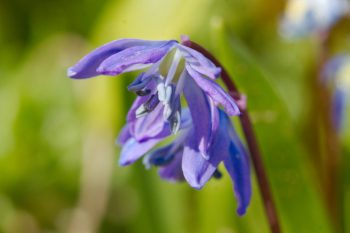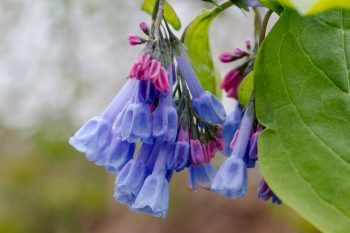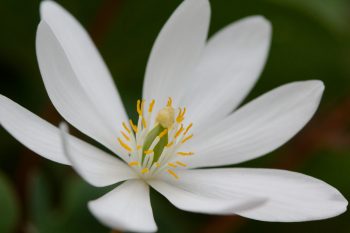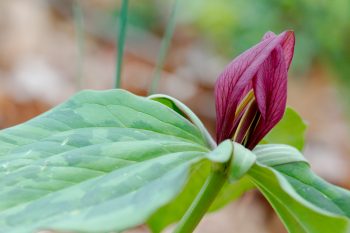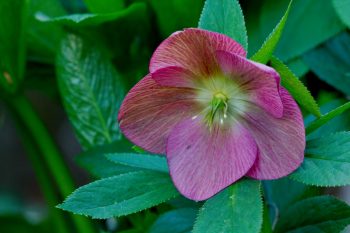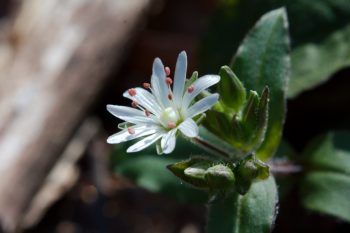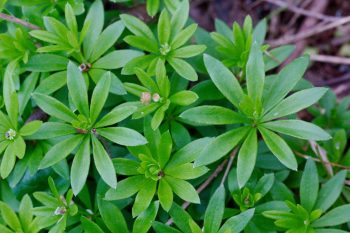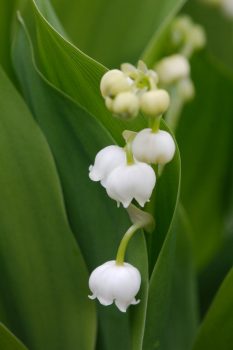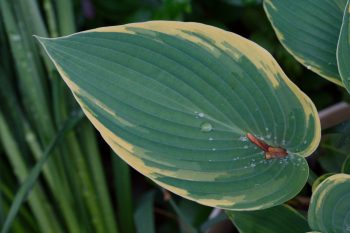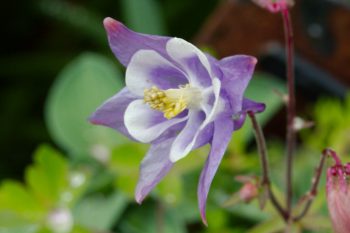I took some photos of the obedient plant (Physostegia virginiana) blooms in the back garden this evening. They are quite pretty when back lit by the sun, as they are here. I was hoping to find some insects to photograph but for whatever reason, there weren’t many this time. There were occasional bees and skippers but I wasn’t able to get close enough to them to photograph. I did manage to get some photos of a sweat bee on the Asclepias but they were not very sharp, so I’ll pass on sharing them.
Tagged With: Hardy Perennial
Physostegia virginiana (Obedient Plant)
Anemone hupehensis var. japonica ‘Pamina’
I know I posted a photo of this Japanese anemone recently but they’re so pretty I thought I’d post another. I got a few pictures with an American hover fly (Eupeodes americanus) on it, but I’ve posted a picture of one of those recently, too, and didn’t see a need to repeat that. We haven’t had much success with anemones in the past but we’re hoping this will do well. It certainly has beautiful flowers and is just the right height for along side our front walk. We really should get a half dozen of them, but one thing at a time.
Rudbeckia Seeds
I took photos of various seeds in the yard this afternoon. First I took pictures of seeds of the Euonymus japonicus. From there I moved on to these Rudbeckia seed heads. I think their form and subtle brown colors. I took photos of blackberry lily Iris domestica fruit, which do have a pretty blackberry-like appearance. I also took a few photos of the tops of Monarda and of the feathery seeds of the Clematis terniflora. None of the photos were wonderful but this one is my favorite. I also took a photo of a robin in the holly tree by the driveway.
Cattails
I left work a little early today and stopped at Redgate Park on the way home. If you’re familiar with Redgate Golf Course, then you now know about Redgate Park. I played this course back in the day—not a lot, only a couple times out of the one or two dozen golf outings of my sporting career—and but it has now been closed and is a park. According to The Sentinel, management of the course was transferred to Billy Casper Golf, a golf-course management company headquartered in Reston, Virginia. I can confirm that the state of the grounds it pretty pitiful.
I walked around a bit and took photos of Asiatic bittersweet (Celastrus orbiculatus) as well as these broadleaf cattails (Typha latifolia). I also saw a nearly frozen snake. I’m pretty sure it was alive but it could barely move in the cold weather. Kind of creepy, actually.
Snow Drops (Galanthus nivalis)
As I mentioned in yesterday’s post, the snow drops (Galanthus nivalis) are coming up in our yard. I remembered that the snow drops in the woods around my office are generally two or three weeks ahead of those in our yard. I went out with my camera this afternoon and sure enough, they are in bloom. There are two large areas, one in the back amidst fallen logs and the other on a steep bank leading down to a stream on the front side of the building. They really are lovely flowers, so simple and yet elegant, especially at a time of year when the ground and most of the things on it are brown.
Lenten Rose ‘Mango Magic’
Our oldest Lenten rose, with its deep maroon colored flowers, has been in bloom for a while. We had such warm weather that a lot of things have been coming up early. We had a cold spell. Not terribly cold but with nighttime temperatures in the 20s. That damaged some of the tender leaves that were just coming up and also some of the buds that were starting to open. This Lenten rose, a variety called ‘Mango Magic’, was not quite as far along so was less damaged, although even here the petals of a few flowers were burned by the frost. Hopefully we’ll have more flowers to come, as it’s warmed up again.
Wild Violet
The wild violets (Viola sororia) are up in the lawn. They’re pretty difficult to get rid of but our lawn is not particularly weed free in general, so they are among the least of our worries. The flowers range in color from nearly all white to nearly all bluish purple. This one is about half way in between. We actually have a few yellow violets and I’m assuming those are a different species, possibly Viola pubescens, but I don’t actually know that. They look very similar to these, except for the flower color.
Chionodoxa forbesii
I think this is my absolute favorite of the spring ephemerals. It’s called glory of the snow in honor of it’s generally very early blooming time, sometimes when there is still snow on the ground. The genus Chionodoxa comes from the Greek words chion meaning snow and doxa meaning glory. I think it’s the color that I like best about it, along with its dainty habit and it’s remarkably easy care. It is hardy as far north as USDA zone 3. In a few short weeks it will be done and gone for the year, sleeping away both the heat of summer and the cold of next winter.
Daffodil ‘Falconet’
One nice thing about being home as we all are is that it means I can get out into the yard during the day. That’s offset by the fact that we can’t go a lot of other places, of course, but we are fortunate to have a pretty nice yard. There’s a huge amount that needs to be done but right now, with the daffodils blooming, it’s quite nice. This little daffodil, one of the Tazetta types, has multiple fragrant flowers on each stem. They were planted in 2014 and are on the edge of the bed that used to surround the spruce tree, which is gone, so they will get a lot more sun now.
Scilla siberica
Blooming shortly after the beautiful, blue Chionodoxa forbesii (glory of the snow), the Scilla siberica (Siberian squill) are starting to come out. They are a darker blue with down-turned flowers but quite similar. In fact, “some experts have merged Chionodoxa into the genus Scilla under the belief that the differences are not significant enough to warrant separate genus status.” (Missouri Botanical Garden, Plant Finder). I don’t really care one way or the other and just enjoy them both as spring ephemerals. I look forward to their bloom every year and don’t think I could have too many of either.
Daffodil ‘Actaea’
This is a daffodil called ‘Actaea’, which is in the poeticus division (division 9), which are distinguished by their large white petals and small, dainty cups in contrasting colors. I think they are fairly posh, compared to their more boisterous cousins but they are similar in their hardiness. They are a bit slower to produce large clumps, though, so if you want a lot of them in a hurry, you’ll want to plant more of them up front. The stems on these are a little less rigid than the others, as well, and they have a tendency to droop even more when it rains but in the sun, they are hard to beat.
Mertensia virginica (Virginia Bluebells)
Like most folks, we’re mostly confined to our house and to walks in the neighborhood. We figured that we could go for a drive so yesterday we went out and about. One place we went was the Montgomery County Agricultural History Farm Park on Muncaster Road. I didn’t take my camera with me, which is pretty unusual, so we went back there today with my camera this time. There were a few others there but everyone kept their distance from one another.
They have a small, woodland garden that is particularly nice right now, with mostly early spring blooms. These Virginia bluebells (Mertensia virginica) are just starting to open and are so lovely.
Sanguinaria canadensis (Bloodroot)
Another photo from our trip to the Montgomery County Agricultural History Farm Park on Muncaster Road. Bloodroot (Sanguinaria canadensis) has very pretty, pure white flowers that don’t last very long. I love them as a true sign of spring. There are some places where you see this native plant in the woods one day as you drive by and then it’s gone the next. The plant is still there, obviously, but not so obvious without it’s bright blooms. The leaves are quite interesting, being deeply-scalloped. The leaves continue growing after the blooms are gone, and are present until mid to late summer when the plant goes dormant.
Trillium
The third and final photo I’ll post from our visit to the Montgomery County Agricultural History Farm Park today. This is trillium and someone more in the know than I am could probably tell you which one. I’ll guess Trillium cuneatum, “the largest and most vigorous of the sessile trilliums that are native to the eastern U. S.” but I stress, that’s just a guess without much research behind it. Whichever it is, it’s a pretty little plant that should be in any woodland garden in our region. They don’t transplant well but it seems to me they would be worth the effort.
Lenten Rose
With Easter in two days, as Lent comes to an end, the Lenten roses are finishing up a very spectacular year. They are pretty reliable, once established, but this year has been particularly good for them in our neck of the woods. This one is either ‘Red Racer’ or ‘Rose Quartz’ and I’d have to check my notes to know which. They were both planted in the fall of 2014 and are near each other but I don’t remember which is which. Regardless, it’s got a really nice color, even as the flowers age.
Stellaria pubera (Star Chickweed)
It was a lovely day today and Cathy and I went for a longish walk (about four miles) near Lake Frank. We saw one of the two bald eagles nesting there, who was by the nest, then flew off and around for a while before landing in another tree near the nest. We saw lots of wildflowers, including this star chickweed (Stellaria pubera), spring beauties (Claytonia virginica), and yellow trout-lily (Erythronium americanum). The ferns were coming up and we saw some jack-in-the-pulpit (Arisaema triphyllum). All in all, a very nice time in the woods.
Galium odoratum (Sweet Woodruff)
This will start blooming in a week or so, but even before it’s in bloom, sweet woodruff (Galium odoratum, also known as sweetscented bedstraw) is quit pretty. In fact, I’d say this photo doesn’t do it justice. The shades of green are just lovely and it makes a really nice groundcover where you don’t need something evergreen. We have a few patches of this and I really like it where it is. It isn’t too aggressive and it fits in very nicely. When crushed, it gives off a strong odor of freshly mown hay, even more so as the plant dries.
Lily of the Valley (Convallaria majalis)
The lily of the valley (Convallaria majalis) is starting to bloom. We have it in a few places around the yard and these are at the front corner of our house where they get just a bit more sun than the other places so are a little ahead. It’s a lovely plant and has lovely, sweetly fragrant flowers but all parts of the plant are very poisonous so if that makes you nervous, you might want to avoid it. It contains cardiac glycosides, “a class of organic compounds that increase the output force of the heart and increase its rate of contractions.”
We dug some up in a yard that was being torn up when a road was being widened and it was growing through asphalt paving, so it’s pretty tenacious. We have it in a fairly large bed in the back yard but it is actually being forced outward by Vinca minor which I wouldn’t have thought possible.
Hosta Leaf
Cathy bought a couple hosta plants last year and put them in a container in the front of our house. If we grow them quite close to the house they do reasonably well but the deer and rabbits really seem to like them and if they are farther from the house, they get eaten. Of course the slugs are just about as likely to get them close to the house, but they don’t consume an entire plant over night. This one, called ‘First Frost’, is one of the two that are in this container and it such a pretty little things.
Columbine (Aquilegia)
We have a number of different columbines in our yard and garden. This one is growing in a container just outside our front door. This is a relatively simple columbine flower, close to what you’d find in the wild. Some others that we have are much fancier and I’ll probably have photos of them in the days to come. They are a reliable bloomer and well worth adding to your garden, blooming after the bulbs are mostly done and before the summer blooms start, so they fill an important role in the garden plan.

